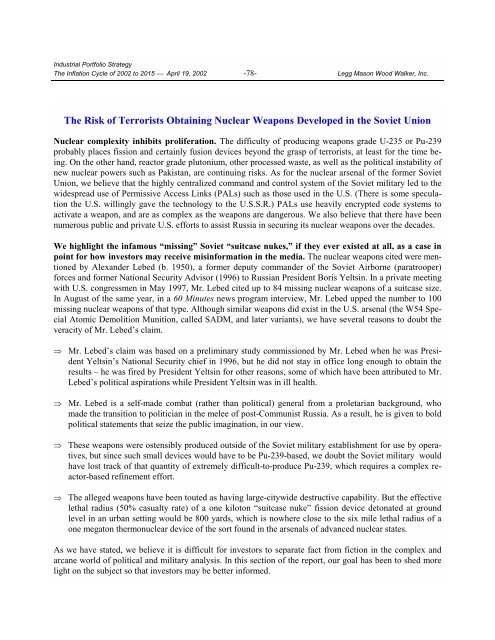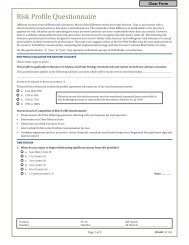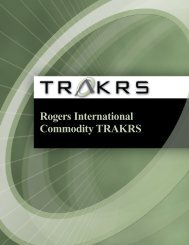The Inflation Cycle of 2002 to 2015 - Uhlmann Price Securities
The Inflation Cycle of 2002 to 2015 - Uhlmann Price Securities
The Inflation Cycle of 2002 to 2015 - Uhlmann Price Securities
Create successful ePaper yourself
Turn your PDF publications into a flip-book with our unique Google optimized e-Paper software.
Industrial Portfolio Strategy<br />
<strong>The</strong> <strong>Inflation</strong> <strong>Cycle</strong> <strong>of</strong> <strong>2002</strong> <strong>to</strong> <strong>2015</strong> ⎯ April 19, <strong>2002</strong> -78- Legg Mason Wood Walker, Inc.<br />
<strong>The</strong> Risk <strong>of</strong> Terrorists Obtaining Nuclear Weapons Developed in the Soviet Union<br />
Nuclear complexity inhibits proliferation. <strong>The</strong> difficulty <strong>of</strong> producing weapons grade U-235 or Pu-239<br />
probably places fission and certainly fusion devices beyond the grasp <strong>of</strong> terrorists, at least for the time being.<br />
On the other hand, reac<strong>to</strong>r grade plu<strong>to</strong>nium, other processed waste, as well as the political instability <strong>of</strong><br />
new nuclear powers such as Pakistan, are continuing risks. As for the nuclear arsenal <strong>of</strong> the former Soviet<br />
Union, we believe that the highly centralized command and control system <strong>of</strong> the Soviet military led <strong>to</strong> the<br />
widespread use <strong>of</strong> Permissive Access Links (PALs) such as those used in the U.S. (<strong>The</strong>re is some speculation<br />
the U.S. willingly gave the technology <strong>to</strong> the U.S.S.R.) PALs use heavily encrypted code systems <strong>to</strong><br />
activate a weapon, and are as complex as the weapons are dangerous. We also believe that there have been<br />
numerous public and private U.S. efforts <strong>to</strong> assist Russia in securing its nuclear weapons over the decades.<br />
We highlight the infamous “missing” Soviet “suitcase nukes,” if they ever existed at all, as a case in<br />
point for how inves<strong>to</strong>rs may receive misinformation in the media. <strong>The</strong> nuclear weapons cited were mentioned<br />
by Alexander Lebed (b. 1950), a former deputy commander <strong>of</strong> the Soviet Airborne (paratrooper)<br />
forces and former National Security Advisor (1996) <strong>to</strong> Russian President Boris Yeltsin. In a private meeting<br />
with U.S. congressmen in May 1997, Mr. Lebed cited up <strong>to</strong> 84 missing nuclear weapons <strong>of</strong> a suitcase size.<br />
In August <strong>of</strong> the same year, in a 60 Minutes news program interview, Mr. Lebed upped the number <strong>to</strong> 100<br />
missing nuclear weapons <strong>of</strong> that type. Although similar weapons did exist in the U.S. arsenal (the W54 Special<br />
A<strong>to</strong>mic Demolition Munition, called SADM, and later variants), we have several reasons <strong>to</strong> doubt the<br />
veracity <strong>of</strong> Mr. Lebed’s claim.<br />
<br />
<br />
<br />
<br />
Mr. Lebed’s claim was based on a preliminary study commissioned by Mr. Lebed when he was President<br />
Yeltsin’s National Security chief in 1996, but he did not stay in <strong>of</strong>fice long enough <strong>to</strong> obtain the<br />
results – he was fired by President Yeltsin for other reasons, some <strong>of</strong> which have been attributed <strong>to</strong> Mr.<br />
Lebed’s political aspirations while President Yeltsin was in ill health.<br />
Mr. Lebed is a self-made combat (rather than political) general from a proletarian background, who<br />
made the transition <strong>to</strong> politician in the melee <strong>of</strong> post-Communist Russia. As a result, he is given <strong>to</strong> bold<br />
political statements that seize the public imagination, in our view.<br />
<strong>The</strong>se weapons were ostensibly produced outside <strong>of</strong> the Soviet military establishment for use by operatives,<br />
but since such small devices would have <strong>to</strong> be Pu-239-based, we doubt the Soviet military would<br />
have lost track <strong>of</strong> that quantity <strong>of</strong> extremely difficult-<strong>to</strong>-produce Pu-239, which requires a complex reac<strong>to</strong>r-based<br />
refinement effort.<br />
<strong>The</strong> alleged weapons have been <strong>to</strong>uted as having large-citywide destructive capability. But the effective<br />
lethal radius (50% casualty rate) <strong>of</strong> a one kilo<strong>to</strong>n “suitcase nuke” fission device de<strong>to</strong>nated at ground<br />
level in an urban setting would be 800 yards, which is nowhere close <strong>to</strong> the six mile lethal radius <strong>of</strong> a<br />
one mega<strong>to</strong>n thermonuclear device <strong>of</strong> the sort found in the arsenals <strong>of</strong> advanced nuclear states.<br />
As we have stated, we believe it is difficult for inves<strong>to</strong>rs <strong>to</strong> separate fact from fiction in the complex and<br />
arcane world <strong>of</strong> political and military analysis. In this section <strong>of</strong> the report, our goal has been <strong>to</strong> shed more<br />
light on the subject so that inves<strong>to</strong>rs may be better informed.








